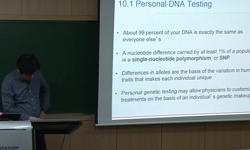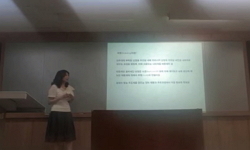The effect of PLGA/HA composite material on cellular adhesion and proliferation was investigated. The composite film was prepared by poly(D,L-lactic-co-glycolic acid) (PLGA) and hydroxyapatite (HA). The PLGA was used as matrix material and the HA part...
http://chineseinput.net/에서 pinyin(병음)방식으로 중국어를 변환할 수 있습니다.
변환된 중국어를 복사하여 사용하시면 됩니다.
- 中文 을 입력하시려면 zhongwen을 입력하시고 space를누르시면됩니다.
- 北京 을 입력하시려면 beijing을 입력하시고 space를 누르시면 됩니다.


Poly(lactic-co-glycolic acid)와 Hydroxyapatite 복합재료 지지체의 연골세포 적합성 연구 (II) = The Effect of Poly(lactic-co-glycolic acid)/Hydroxyapatite CompositeScaffold on Chondrocyte Cyto-compatibility (II)
한글로보기https://www.riss.kr/link?id=A103814770
- 저자
- 발행기관
- 학술지명
- 권호사항
-
발행연도
2008
-
작성언어
Korean
- 주제어
-
등재정보
KCI등재,SCIE
-
자료형태
학술저널
-
수록면
77-81(5쪽)
-
KCI 피인용횟수
1
- 제공처
-
0
상세조회 -
0
다운로드
부가정보
다국어 초록 (Multilingual Abstract)
was prepared by poly(D,L-lactic-co-glycolic acid) (PLGA) and hydroxyapatite (HA). The PLGA was used as matrix material
and the HA particles were incorporated as reinforcing material. The HA particles were mixed in 5, 10 and 15 wt%
with PLGA for preparing PLGA/HA composite film and scaffold. Mechanical property of the composite film was characterized
by tensile test. The ultimate tensile strength of 10 wt% HA content film was two-fold higher than control
group. Surface of the composite films and scaffolds were characterized by contact angle measurement and scanning
electron microscope (SEM). The PLGA/HA composites were more hydrophilic than control group. The SEM picture
showed that the pores in the PLGA/HA composite scaffold were clearly observed as the pores in the PLGA scaffold
(control). For the PLGA/HA composite scaffold, compression test was performed. The compressive stress was decreased
with increasing the amount of HA. This is the same phenomenon as the tensile test for composite film. For cell-compatibility,
cellular attachment and proliferation were significantly higher on PLGA/HA (10 wt%) composite film than
control group (1.5 times higher in attachment test and 1.3 times higher for 6th-day culture in proliferation assaying,
p<0.05). However, the PLGA/HA (10wt%) composite scaffold showed not as good result as the film has. For 3-D scaffold
structure, it is presumed that other geometrical factors may important role in cellular adhesion and proliferation.
The effect of PLGA/HA composite material on cellular adhesion and proliferation was investigated. The composite film
was prepared by poly(D,L-lactic-co-glycolic acid) (PLGA) and hydroxyapatite (HA). The PLGA was used as matrix material
and the HA particles were incorporated as reinforcing material. The HA particles were mixed in 5, 10 and 15 wt%
with PLGA for preparing PLGA/HA composite film and scaffold. Mechanical property of the composite film was characterized
by tensile test. The ultimate tensile strength of 10 wt% HA content film was two-fold higher than control
group. Surface of the composite films and scaffolds were characterized by contact angle measurement and scanning
electron microscope (SEM). The PLGA/HA composites were more hydrophilic than control group. The SEM picture
showed that the pores in the PLGA/HA composite scaffold were clearly observed as the pores in the PLGA scaffold
(control). For the PLGA/HA composite scaffold, compression test was performed. The compressive stress was decreased
with increasing the amount of HA. This is the same phenomenon as the tensile test for composite film. For cell-compatibility,
cellular attachment and proliferation were significantly higher on PLGA/HA (10 wt%) composite film than
control group (1.5 times higher in attachment test and 1.3 times higher for 6th-day culture in proliferation assaying,
p<0.05). However, the PLGA/HA (10wt%) composite scaffold showed not as good result as the film has. For 3-D scaffold
structure, it is presumed that other geometrical factors may important role in cellular adhesion and proliferation.
참고문헌 (Reference)
1 Horst Claassen, 183 : 223-227, 2001
2 H. Janice Lee, 27 : 5268-5276, 2006
3 J.J.A. Barry, 25 : 3559-3568, 2004
4 Sarah E. Petricca, 2 : 277-, 2006
5 A. Ciorba, "Tissue engineering and cartilage regeneration for auricular reconstruction" 70 : 1507-1515, 2006
6 D.W. Hutmacher, "Scaffolds in tissue engineering bone and cartilage" 21 : 2529-2543, 2000
7 M. Kikuchi, "Preparation and mechanical properties of calcium phosphate/copoly-Llactide composites" 8 : 361-364, 1997
8 Zhongkui Hong, "Nano-composite of poly(L-lactide) and surface grafted hydroxyapatite: Mechanical properties and biocompatibility" 26 : 6296-6304, 2005
9 C. Durucan, "Journal of Biomedical Materials Research" 51 : 717-725, 2000
10 J. B. Lee, "Improved Attachment and Proliferation of Porcine Articular Chondrocyte" 한국생체재료학회 10 (10): 196-200, 2006
1 Horst Claassen, 183 : 223-227, 2001
2 H. Janice Lee, 27 : 5268-5276, 2006
3 J.J.A. Barry, 25 : 3559-3568, 2004
4 Sarah E. Petricca, 2 : 277-, 2006
5 A. Ciorba, "Tissue engineering and cartilage regeneration for auricular reconstruction" 70 : 1507-1515, 2006
6 D.W. Hutmacher, "Scaffolds in tissue engineering bone and cartilage" 21 : 2529-2543, 2000
7 M. Kikuchi, "Preparation and mechanical properties of calcium phosphate/copoly-Llactide composites" 8 : 361-364, 1997
8 Zhongkui Hong, "Nano-composite of poly(L-lactide) and surface grafted hydroxyapatite: Mechanical properties and biocompatibility" 26 : 6296-6304, 2005
9 C. Durucan, "Journal of Biomedical Materials Research" 51 : 717-725, 2000
10 J. B. Lee, "Improved Attachment and Proliferation of Porcine Articular Chondrocyte" 한국생체재료학회 10 (10): 196-200, 2006
11 Chih-Hung Chang et al, "Gelatin-chondroitin-hyaluronan tricopolymer scaffold for cartilage tissue engineering" 24 : 4853-4858, 2003
12 C.-H. Chang, "Gelatin-chondroitin-hyaluronan tri-copolymer scaffold for cartilage tissue engineering" 24 : 4853-4858, 2003
13 S. -S. Kim, "Effects of hydroxyapatite in 3-D chitosan-gelatin polymer network on human mesenchymal stem cell construct development" 27 : 1859-1867, 2006
14 Y.Z. Wang, "Cartilage tissue engineering with silk scaffolds and human articular chondrocytes" 27 : 4434-4442, 2006
동일학술지(권/호) 다른 논문
-
- 한국생체재료학회
- 김혜정
- 2008
- KCI등재,SCIE
-
- 한국생체재료학회
- 임군일
- 2008
- KCI등재,SCIE
-
온도 민감성 Elastin-like Polypeptide의 생체재료에의 응용
- 한국생체재료학회
- 정재연
- 2008
- KCI등재,SCIE
-
Cyclosporine A에 의한 치은과증식의 형태학적 특성과 기전 및 치료
- 한국생체재료학회
- 박정철
- 2008
- KCI등재,SCIE
분석정보
인용정보 인용지수 설명보기
학술지 이력
| 연월일 | 이력구분 | 이력상세 | 등재구분 |
|---|---|---|---|
| 2023 | 평가예정 | 해외DB학술지평가 신청대상 (해외등재 학술지 평가) | |
| 2020-01-01 | 평가 | 등재학술지 유지 (해외등재 학술지 평가) |  |
| 2017-01-01 | 평가 | 등재학술지 유지 (계속평가) |  |
| 2013-01-01 | 평가 | 등재 1차 FAIL (등재유지) |  |
| 2010-01-01 | 평가 | 등재학술지 유지 (등재유지) |  |
| 2007-01-01 | 평가 | 등재학술지 선정 (등재후보2차) |  |
| 2006-01-01 | 평가 | 등재후보 1차 PASS (등재후보1차) |  |
| 2005-03-28 | 학회명변경 | 한글명 : 생체재료학회 -> 한국생체재료학회영문명 : 미등록 -> The Korean Society For Biomaterials |  |
| 2005-03-28 | 학술지등록 | 한글명 : 생체재료학회지외국어명 : Biomaterials Research |  |
| 2004-07-01 | 평가 | 등재후보학술지 선정 (신규평가) |  |
학술지 인용정보
| 기준연도 | WOS-KCI 통합IF(2년) | KCIF(2년) | KCIF(3년) |
|---|---|---|---|
| 2016 | 0.32 | 0.32 | 0.3 |
| KCIF(4년) | KCIF(5년) | 중심성지수(3년) | 즉시성지수 |
| 0.26 | 0.23 | 0.511 | 0.11 |




 KCI
KCI





